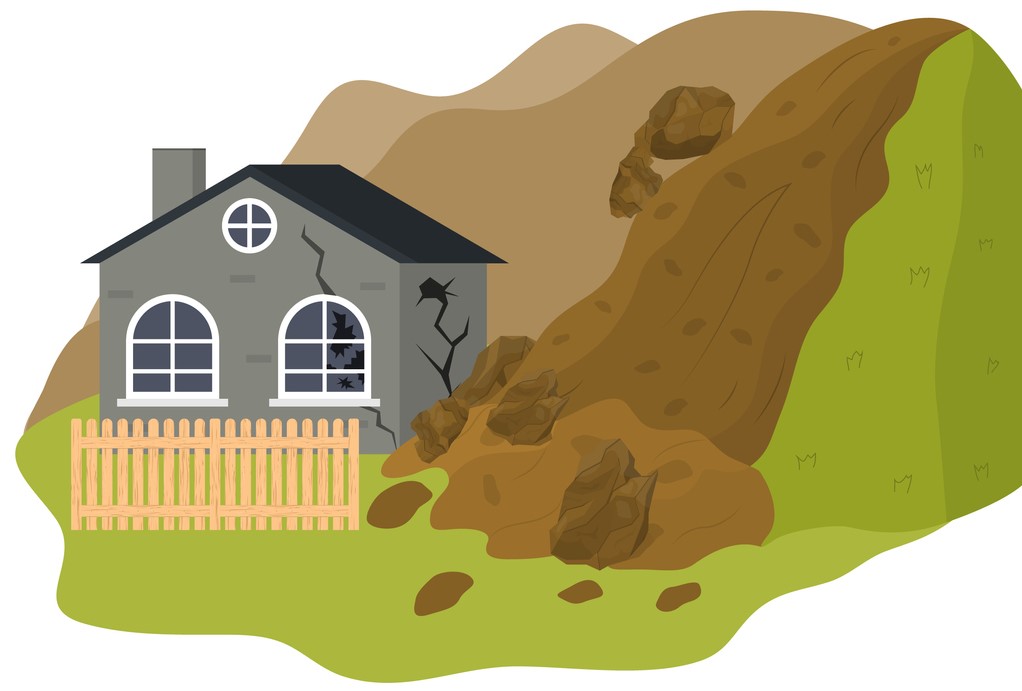A condominium made a claim arguing that unstable excavation material, which became heavy enough due to spring runoff, fell down a mountainside, causing damage to the condominium.1 The condominium made the following factual argument for coverage:
[T]he excavated soil is more like a ‘falling object’ which is covered by the insurance policy’s Additional Coverage section of the policy which addresses a partial or total collapse that results from a ‘falling object.’ Defendant’s engineer, W. Paul Grant, opines that ‘[t]he movement of the stockpile is analogous to that of a failure of an improperly constructed building which falls and causes damage to adjacent property, in that both events are caused by poor construction and not adhering to building codes.’
The insurance company denied the claim, saying the damage was excluded because the cause was mudslide or mudflow and that the earth movement could not be deemed a “falling object.”
The policy language stated:
d. Collapse
(1) We will pay for direct physical loss or damage to Covered Property, caused by collapse of a building or any part of a building insured under this policy if the collapse is caused by one or more of the following:
(a) the ‘specified causes of loss’ …
Under property definitions, the policy stated:
H. Property Definitions
6. Specified Causes of Loss means the following:
Fire, lightning, explosion, windstorm, or hail, smoke, aircraft or vehicles, riot or civil commotion, vandalism, leakage from fire extinguishing equipment, sinkhole collapse, volcanic action; falling objects; weight of snow, ice or sleet; water damage.
b. Falling objects does not include loss of or damage to:
(1)Personal property in the open; or
(2) The interior of a building or structure, or property inside a building or structure, unless the roof or an outside wall of building the or structure is first damaged by falling object.
Readers of this blog will recall from What Are the Specified Perils? What Is Falling Objects?, that the third edition of Property Loss Adjusting noted the following about Falling Objects Coverage:
Much of the damage caused by falling objects is covered under the vandalism, windstorm, aircraft, and lightning perils. Any other damage from falling objects is covered only under a special-form policy or a policy in which the falling objects is a specified peril. The falling object must make a hole in the structure’s exterior for coverage to apply.
The treatise was referring to this typical definition of falling objects, which excluded certain types of damage. I do not believe the definition requires “a hole,” although that may happen. Rather, the falling object must strike the exterior of the building causing damage to the exterior.
The court asked, “Does the excavated material qualify as a falling object?” and then made this observation and ruling about the coverage term “falling object:”
The policy does not define ‘falling object.’ While the policy is clear that falling objects are included in the definition of ‘specified causes of loss’ which fall under the collapse coverage, the policy is ambiguous on what is considered a falling object. Even applying the plain and ordinary meaning to the term ‘falling objects’ does not help as there are numerous definitions to each word. ‘Fall’ is defined by Webster’s Ninth New Collegiate Dictionary as ‘the act of falling by the force of gravity’ and ‘object’ is defined as ‘something material that may be perceived by the senses.’ There are, of course, numerous other definitions for the words ‘fall’ and ‘object,’ but the Court has tried to select the ordinary definitions most applicable to the context of the insurance policy at issue.
…
As stated earlier, an insurance policy is ambiguous if it is subject to conflicting interpretations and the Court finds the term ‘falling objects’ is ambiguous in this particular case. In making this finding, the Court does not intend to indicate it believes the earth movement was a falling object. Rather, the Court finds there is a genuine issue of fact for the factfinder to determine if the earth movement was or was not a falling object in the plain sense of the words (as opposed to whether the earth movement could be ‘analogous’ to a falling object). Because ambiguities must be construed against the insurer,… the Court will assume for purposes of this motion that the earth movement could be a falling object under the terms of the policy.
The court, unfortunately, ruled that the mudflow was also excluded “earth movement” and excluded under the policy language:
The specific language of the exclusions states ‘We will not pay for loss or damage caused directly or indirectly by any of the following. Such loss or damage is excluded regardless of any other cause or event that contributes concurrently or in any sequence to the loss.’ If the falling object is also directly or indirectly a mudflow or mudslide, which this Court has found in the earlier portion of this Order, then the requested coverage for a falling object that is also a mudflow or mudslide would be excluded by the terms of the insurance contract. This interpretation is also consistent with the collapse coverage language that limits coverage for ‘specified causes of loss’ to ‘all only as insured against in this policy.’ Since mudflows and mudslides are specifically excluded in the Exclusions portions of the policy, the collapse coverage for falling objects cannot put this particular factual scenario outside of the specific exclusions listed and summary judgment must be granted in favor of Plaintiff.
The case stands for the proposition that “falling objects” will be broadly interpreted. However, debris falling down a mountainside that is within a mudflow or mudslide may constitute “earth movement” and be excluded from coverage.
I would suggest that those interested in “falling objects’ also read Falling Objects Coverage – Are You Covered For That Tree Limb That Just Came Through Your Roof?
Thought For The Day
Sometimes fate is like a small sandstorm that keeps changing directions. You change direction but the sandstorm chases you. You turn again, but the storm adjusts.
—Haruki Murakami in “Kafka on the Shore”




